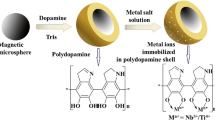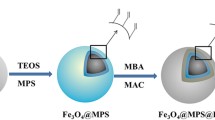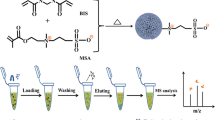Abstract
In this work, we demonstrate for the first time, a method to synthesize phenylboronic acid-Fe3O4@polydopamine (Fe3O4@PDA-PBA) magnetic microspheres via the combination of mussel-inspired polydopamine coating and click chemistry. Uniform-size and core-shell structured Fe3O4@PDA-PBA magnetic microspheres with a core diameter of ∼240 nm and a shell thickness of ∼13 nm were obtained as identified by the characterization of the morphology, structure and composition of the synthesized microspheres. We evaluated the selectivity and binding capacity of the Fe3O4@PDA-PBA magnetic microspheres by using standard glycoproteins (ovalbumin, immunoglobulin G and catalase) and nonglycoproteins (human serum albumin, bovine hemoglobin, myoglobin, lysozyme, and ribonuclease A) as model proteins. Adsorption experiments, SDS-PAGE and mass spectrometry analysis demonstrated that the Fe3O4@PDA-PBA magnetic microspheres had much high binding capacity and selectivity for glycoproteins/glycopeptides compared to nonglycoproteins/nonglycopeptides. In addition, the practicability of the Fe3O4@PDA-PBA magnetic microspheres was further assessed by selective capture of glycoproteins from healthy human serum. The good results demonstrated its potential in glycoproteome analysis.
Similar content being viewed by others
References
Ohtsubo K, Marth JD. Glycosylation in cellular mechanisms of health and disease. Cell, 2006, 126: 855–867
Wada Y, Tajiri M, Yoshida S. Hydrophilic affinity isolation and MALDI multiple-stage tandem mass spectrometry of glycopeptides for glycoproteomics. Anal Chem, 2004, 76: 6560–6565
Chen ML, Li LM, Yuan BF, Ma Q, Feng YQ. Preparation and characterization of methacrylate-based monolith for capillary hydrophilic interaction chromatography. J Chromatogr A, 2012, 1230: 54–60
Chen R, Jiang XN, Sun DG, Han GH, Wang FJ, Ye ML, Wang LM, Zou HF. Glycoproteomics analysis of human liver tissue by combination of multiple enzyme digestion and hydrazide chemistry. J Proteome Res, 2009, 8: 651–661
Sun Z, Qin HQ, Wang FJ, Cheng K, Dong MM, Ye ML, Zou HF. Capture and dimethyl labeling of glycopeptides on hydrazide beads for quantitative glycoproteomics analysis. Anal Chem, 2012, 84: 8452–8456
Qiu R, Regnier FE. Use of multidimensional lectin affinity chromatography in differential glycoproteomics. Anal Chem, 2005, 77: 2802–2809
Zeng Z, Hincapie M, Pitteri SJ, Hanash S, Schalkwijk J, Hogan JM, Wang H, Hancock WS. A proteomics platform combining depletion, multi-lectin affinity chromatography (M-LAC), and isoelectric focusing to study the breast cancer proteome. Anal Chem, 2011, 83: 4845–4854
Liu YC, Ren LB, Liu Z. A unique boronic acid functionalized monolithic capillary for specific capture, separation and immobilization of cis-diol biomolecules. Chem Commun, 2011, 47: 5067–5069
Lin ZA, Pang JL, Yang HH, Cai ZW, Zhang L, Chen GN. One-pot synthesis of an organic-inorganic hybrid affinity monolithic column for specific capture of glycoproteins. Chem Commun, 2011, 47: 9675–9677
Lin ZA, Pang JL, Lin Y, Huang H, Cai ZW, Zhang L, Chen GN. Preparation and evaluation of a phenylboronate affinity monolith for selective capture of glycoproteins by capillary liquid chromatography. Analyst, 2011, 136: 3281–3288
Li HY, Wang HY, Liu YC, Liu Z. A benzoboroxole-functionalized monolithic column for the selective enrichment and separation of cis-diol containing biomolecules. Chem Commun, 2012, 48: 4115–4117
Lu Y, Bie ZJ, Liu YC, Liu Z. Fine-tuning the specificity of boronate affinity monoliths toward glycoproteins through pH manipulation. Analyst, 2013, 138: 290–298
Springsteen G, Wang B. A detailed examination of boronic acid-diol complexation. Tetrahedron, 2002, 58: 5291–5300
Colombo M, Carregal-Romero S, Casula MF, Gutiérrez L, Morales MP, Böhm IB, Heverhagen JT, Prosperi D, Parak WJ. Biological applications of magnetic nanoparticles. Chem Soc Rev, 2012, 41: 4306–4334
Zhou W, Yao N, Yao GP, Deng CH, Zhang XM, Yang PY. Facile synthesis of aminophenylboronic acid-functionalized magnetic nano-particles for selective separation of glycopeptides and glycoproteins. Chem Commun, 2008: 5577–5579
Lin ZA, Zheng JN, Lin F, Zhang L, Cai ZW, Chen GN. Synthesis of magnetic nanoparticles with immobilized aminophenylboronic acid for selective capture of glycoproteins. J Mater Chem, 2011, 21: 518–524
Wang H, Bie Z, Lu C, Liu Z. Magnetic nanoparticles with dendrimer-assisted boronate avidity for the selective enrichment of trace glycoproteins. Chem Sci, 2013, 4: 4298–4303
Zhang LJ, Xu YW, Yao HL, Xie LQ, Yao J, Lu HJ, Yang PY. Boronic acid functionalized core-satellite composite nanoparticles for advanced enrichment of glycopeptides and glycoproteins. Chem Eur J, 2009, 15: 10158–10166
Qi DW, Zhang HY, Tang J, Deng CH, Zhang XM. Facile Synthesis of mercaptophenylboronic acid-functionalized core-shell structure Fe3O4@C@Au magnetic microspheres for selective enrichment of glycopeptides and glycoproteins. J Phys Chem C, 2010, 114: 9221–9226
Lin ZA, Zheng JN, Xia ZW, Yang HH, Zhang L, Chen GN. One-pot synthesis of phenylboronic acid-functionalized core-shell magnetic nanoparticles for selective enrichment of glycoproteins. RSC Adv, 2012, 2: 5062–5065
Pan MR, Sun YF, Zheng J, Yang WL. Boronic acid-functionalized core-shell-shell magnetic composite microspheres for the selective enrichment of glycoprotein. ACS Appl Mater Interfaces, 2013, 5: 8351–8358
Zhang XH, He XW, Chen LX, Zhang YK. Boronic acid modified magnetic nanoparticles for enrichment of glycoproteins via azide and alkyne click chemistry. J Mater Chem, 2012, 22: 16520–16526
Zhang ST, He XW, Chen LX, Zhang YK. Boronic acid functionalized magnetic nanoparticles via thiol-ene click chemistry for selective enrichment of glycoproteins. New J Chem, 2014, 38: 4212–4218
Zhang XH, He XW, Chen LX, Zhang YK. A combination of distillation-precipitation polymerization and click chemistry: fabrication of boronic acid functionalized Fe3O4 hybrid composites for enrichment of glycoproteins. J Mater Chem B, 2014, 2: 3254–3262
Lee H, Dellatore SM, Miller WM, Messersmith PB. Mussel-inspired surface chemistry for multifunctional coatings. Science, 2007, 318: 426–430
Ye Q, Zhou F, Liu WM. Bioinspired catecholic chemistry for surface modification. Chem Soc Rev, 2011, 40: 4244–4258
Links DA, Li N, Binder WH. Click-chemistry for nanoparticle-modification. J Mater Chem, 2011, 21: 16717–16734
Haque M, Peng XH. DNA-associated click chemistry. Sci China Chem, 2014, 57: 215–231
Deng H, Li XL, Peng Q, Wang X, Chen JP, Li YD. Monodisperse magnetic single-grystal ferrite microspheres. Angew Chem Int Ed, 2005, 44: 2782–2785
Zhou WH, Lu CH, Guo XC, Chen FR, Yang HH, Wang XR. Mussel-inspired molecularly imprinted polymer coating superparamagnetic nanoparticles for protein recognition. J Mater Chem, 2010, 20: 880–883
Boechat N, Ferreira VF, Ferreira SB, Ferreira M de G, da Silva F de C, Bastos MM, Costa M dos S, Lourenço MCS, Pinto AC, Krettli AU, Aguiar AC, Teixeira BM, da Silva NV, Martins PRC, Bezerra FAFM, Camilo ALS, da Silva GP, Costa CCP. Novel 1,2,3-triazole derivatives for use against mycobacterium tuberculosis H37Rv (ATCC 27294) strain. J Med Chem, 2011, 54: 5988–5999
Borlido L, Azevedo AM, Roque ACA, Aires-Barros MR. Potential of boronic acid functionalized magnetic particles in the adsorption of human antibodies under mammalian cell culture conditions. J Chromatogr A, 2011, 1218: 7821–7827
Wuhrer M, Koeleman CAM, Hokke CH, Deelder AM. Protein glycosylation analyzed by normal-phase nano-liquid chromatography-mass spectrometry of glycopeptides. Anal Chem, 2005, 77: 886–894
Author information
Authors and Affiliations
Corresponding authors
Rights and permissions
About this article
Cite this article
Zheng, J., Lin, Z., Zhang, L. et al. Polydopamine-mediated immobilization of phenylboronic acid on magnetic microspheres for selective enrichment of glycoproteins and glycopeptides. Sci. China Chem. 58, 1056–1064 (2015). https://doi.org/10.1007/s11426-014-5286-5
Received:
Accepted:
Published:
Issue Date:
DOI: https://doi.org/10.1007/s11426-014-5286-5




